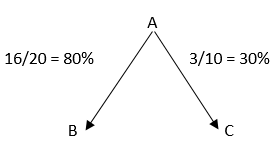Date
20/6/2016
21/7/2016
18/8/2016
|
Details
Cash balance b/d
Add: Realization
Less: Trade payables
Add: Realization 2.
Less: Bank overdraft
Less: Loan - Ali
Less: Dissolution expenses
Cash balance
Capital balance b/d
Minimum possible loss
Distribution 1
Capital balance
Less:Realization 3
Maximum loss
Distribution 2
Capital balance
Less:Realization 4
Maximum loss
Distribution 3 |
Amount
80
30,000
(28,000)
125,000
(64,180)
(10,000)
(1,000)
51,900
(135,000)
(83,100)
↓
83,100
(34,000)
49,100
↓
49,100
(39,000)
10,100
|
Ali
70,000
(33,240)
36,760
33,240
(19,640)
13,600
19,640
4,040
15,600 |
Baba
45,000
(33,240)
11,760
33,240
(19,640)
13,600
19,640
4,040
15,600 |
Chake
20,000
(16,260)
3,380
16,620
(9,820)
6,800
9,820
2,020
7,800 |






